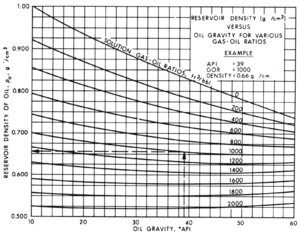Difference between revisions of "Static oil pressure gradient estimation"
Jump to navigation
Jump to search
Cwhitehurst (talk | contribs) |
Cwhitehurst (talk | contribs) m (added Category:Treatise Handbook 3 using HotCat) |
||
| (10 intermediate revisions by 2 users not shown) | |||
| Line 6: | Line 6: | ||
| part = Critical elements of the petroleum system | | part = Critical elements of the petroleum system | ||
| chapter = Formation fluid pressure and its application | | chapter = Formation fluid pressure and its application | ||
| − | | frompg = 5- | + | | frompg = 5-20 |
| − | | topg = 5- | + | | topg = 5-25 |
| author = Edward A. Beaumont, Forrest Fiedler | | author = Edward A. Beaumont, Forrest Fiedler | ||
| link = http://archives.datapages.com/data/specpubs/beaumont/ch05/ch05.htm | | link = http://archives.datapages.com/data/specpubs/beaumont/ch05/ch05.htm | ||
| Line 14: | Line 14: | ||
| isbn = 0-89181-602-X | | isbn = 0-89181-602-X | ||
}} | }} | ||
| − | The static oil pressure gradient is dependent on oil density. Subsurface density of oil or condensate depends on composition, amount of dissolved | + | The static oil pressure gradient is dependent on oil [[Wikipedia:Density|density]]. Subsurface density of oil or condensate depends on [[Oil composition|composition]], amount of [[dissolved gas]]es, [[Wikipedia:Temperature|temperature]], and [[Wikipedia:Pressure|pressure]]. [[Oil and condensate analysis|Oil or condensate density]] can be estimated to useful accuracy if stock tank [[API gravity]] and [[Petroleum reservoir fluid properties#Solution gas-oil ratio (GOR)|solution gas-oil ratio (GOR)]] are known.<ref name=ch05r15>Schowalter, T., T., 1979, [http://archiveSolution gas-oil ratio (GOR)s.datapages.com/data/bulletns/1977-79/data/pg/0063/0005/0700/0723.htm Mechanics of secondary hydrocarbon migration and entrapment]: AAPG Bulletin, vol. 63, no. 5, p. 723–760. Covers many fluid behavior principles, including pressure, with broad application to petroleum exploration.</ref> |
==Estimating oil pressure gradients== | ==Estimating oil pressure gradients== | ||
Follow the steps listed below to estimate static oil pressure gradient. | Follow the steps listed below to estimate static oil pressure gradient. | ||
| − | + | # Estimate oil density using Figure 1. | |
| − | + | # Estimate oil pressure gradient using the following formula: | |
| − | |||
| − | |||
| − | |||
| − | |||
| − | |||
| − | |||
| − | |||
| − | |||
:<math>\mbox{P}_{\rm oil\ grad} = \rho_{\rm oil} \times 0.433 \mbox{ psi/ft}</math> | :<math>\mbox{P}_{\rm oil\ grad} = \rho_{\rm oil} \times 0.433 \mbox{ psi/ft}</math> | ||
| Line 35: | Line 27: | ||
* P<sub>oil grad</sub> = oil pressure gradient | * P<sub>oil grad</sub> = oil pressure gradient | ||
* ρ<sub>oil</sub> = oil density | * ρ<sub>oil</sub> = oil density | ||
| − | |||
==Determining oil density== | ==Determining oil density== | ||
| − | [[file:formation-fluid-pressure-and-its-application_fig5-7.png|thumb|{{figure number|1}}.]] | + | [[file:formation-fluid-pressure-and-its-application_fig5-7.png|300px|thumb|{{figure number|1}}Determining oil density.]] |
Use [[:file:formation-fluid-pressure-and-its-application_fig5-7.png|Figure 1]] to determine oil density. If the GOR is unknown or if there is no dissolved gas in the oil, use the 0 line. | Use [[:file:formation-fluid-pressure-and-its-application_fig5-7.png|Figure 1]] to determine oil density. If the GOR is unknown or if there is no dissolved gas in the oil, use the 0 line. | ||
| Line 47: | Line 38: | ||
* [[Estimating static gas pressure gradients]] | * [[Estimating static gas pressure gradients]] | ||
* [[Plotting the hydrocarbon pressure gradient]] | * [[Plotting the hydrocarbon pressure gradient]] | ||
| − | * [[ | + | * [[Free water level determination using pressure]] |
==References== | ==References== | ||
| Line 59: | Line 50: | ||
[[Category:Critical elements of the petroleum system]] | [[Category:Critical elements of the petroleum system]] | ||
[[Category:Formation fluid pressure and its application]] | [[Category:Formation fluid pressure and its application]] | ||
| + | [[Category:Treatise Handbook 3]] | ||
Latest revision as of 15:18, 17 February 2022
| Exploring for Oil and Gas Traps | |

| |
| Series | Treatise in Petroleum Geology |
|---|---|
| Part | Critical elements of the petroleum system |
| Chapter | Formation fluid pressure and its application |
| Author | Edward A. Beaumont, Forrest Fiedler |
| Link | Web page |
| Store | AAPG Store |
The static oil pressure gradient is dependent on oil density. Subsurface density of oil or condensate depends on composition, amount of dissolved gases, temperature, and pressure. Oil or condensate density can be estimated to useful accuracy if stock tank API gravity and solution gas-oil ratio (GOR) are known.[1]
Estimating oil pressure gradients[edit]
Follow the steps listed below to estimate static oil pressure gradient.
- Estimate oil density using Figure 1.
- Estimate oil pressure gradient using the following formula:
where:
- Poil grad = oil pressure gradient
- ρoil = oil density
Determining oil density[edit]
Use Figure 1 to determine oil density. If the GOR is unknown or if there is no dissolved gas in the oil, use the 0 line.
See also[edit]
- Static hydrocarbon pressure gradients
- Estimating static gas pressure gradients
- Plotting the hydrocarbon pressure gradient
- Free water level determination using pressure
References[edit]
- ↑ Schowalter, T., T., 1979, gas-oil ratio (GOR)s.datapages.com/data/bulletns/1977-79/data/pg/0063/0005/0700/0723.htm Mechanics of secondary hydrocarbon migration and entrapment: AAPG Bulletin, vol. 63, no. 5, p. 723–760. Covers many fluid behavior principles, including pressure, with broad application to petroleum exploration.

